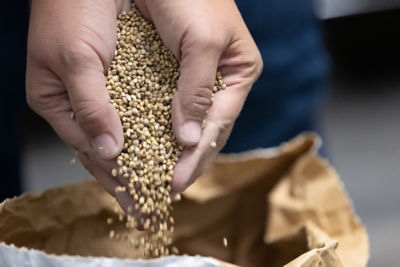Click here to download a PDF version of this spotlight.
» Herbicides are important tools to help manage pigweed species in vegetable production systems.
» Pigweed populations that are resistant to commonly used herbicides are present in many production areas of North America.
» Plans for resistance management can help minimize the development of herbicide-resistant pigweed populations.
HERBICIDES AND PIGWEEDS
Pigweeds, including redroot pigweed, smooth pigweed, Palmer amaranth, Powell amaranth, and waterhemp, are some of the most problematic weed species for crop production in the United States.1,2 In vegetable cropping systems, management of pigweeds often relies on the integration of methods to help eliminate germinated seedlings, lower seed levels in the seed bank, inhibit weed growth, and reduce the use of herbicides. Several herbicides belonging to different herbicide classes are available for pigweed management in vegetable crops.3,4 Both preemergence and postemergence herbicides are available, but postemergence herbicides are often used because most pigweed species germinate and emerge after soil temperatures warm sufficiently.5
The availability of specific herbicides varies with location and the vegetable crops being grown, so growers should consult regional production guides and product labels for information on restrictions and use. The Midwest Vegetable Production Guide for Commercial Growers, 2023, lists active ingredients that can be used for the control of pigweed/amaranth species, depending on specific crop registrations (Table 1). Many of these herbicides are listed as excellent or good for managing pigweeds when applied after emergence when weed seedlings are less than three inches tall. A few of the products are effective when applied before emergence to soil surfaces.
HERBICIDES RESISTANCE
Unfortunately, some pigweed populations have developed resistance to some of the commonly used herbicide active ingredients. Pigweed species generally have a high level of genetic diversity, abundant seed production, and efficient mechanisms of seed distribution. These factors are favorable for the development of herbicide resistance.2 Pigweed/ amaranth populations have been found with resistance to ALS-inhibitors (group 2), including halosulfuron, imazethapyr, rimsulfuron, and thifensulfuron; photosystem II inhibitors (group 5 and 7), including promethryne and linuron; dinitroanilines (group 3); HPPD-inhibitors (group 27); and EPSP-Synthesis inhibitors (group 9) including glyphosate.1,2,8,9 Widespread and regular use of specific active ingredients or those with similar modes of action can increase the likelihood that resistant weed populations will develop.
The occurrence of populations of Palmer amaranth and other pigweed species with resistance to ALS-inhibitor herbicides are widespread in the U.S., and many of these populations show cross-resistance to several herbicides in this group.1,2 Cross-resistance means that a population that develops resistance to one active ingredient is also (at least somewhat) resistant to some of the other active ingredients in the same herbicide class or group. When resistant populations are present, the use of products with those active ingredients may no longer provide effective management of those pigweed species.10
Certain gene mutations can result in herbicide resistance in individual plants. These plants then have a reproductive advantage where those herbicides are used, and resistant populations can develop over time. Several different forms of resistance have been characterized. Target site resistance (TSR) results from genetic changes that alter the herbicide binding site, reducing the ability of the active ingredient to bind to the plant cells and affect plant growth. Another TSR mechanism is the overproduction of the target protein. This allows most of the available active ingredient to be bound, but still leaves enough non-bound protein left over to perform the needed function for the plant. TSR types of resistance can result in cross-resistance to other active ingredients with the same or similar mode of action.1,11
Non-target site resistance (NTSR) mechanisms affect non-binding-site genes. The effects of these genetic modifications can reduce the uptake and/or translocation of the active ingredient within the plant. They can also increase the metabolism of the herbicide by the plant to detoxify the chemical, decrease herbicide activation rates, or increase herbicide sequestration. NTSR forms of resistance are often polygenic and do not target the specific binding site of the active ingredient. Therefore, NTSR forms of resistance may confer resistance to multiple modes of action (herbicides belonging to different groups).1,11 Both TSR and NTSR forms of herbicide resistance have been found in pigweed species.1 Understanding the mechanisms of resistance can be important when designing resistance management practices.

RESISTANCE MANAGEMENT
Several strategies can be used to help reduce the development of herbicide-resistant weed populations. Growers should rotate the use of herbicide groups or use mixtures of herbicides from different groups. Any weeds that survive the first application because of resistance will likely be eliminated by the different MOA of the next application. Using different herbicides with similar MOAs (belonging to the same herbicide group) will not be as effective in limiting the development of resistant weeds.12 Applying mixtures of two or more herbicides with different MOAs accomplishes the same thing as a rotation. Some products come as mixtures of active ingredients with different MOAs. Tank mixtures of two or more products can also be used if the products are compatible.1,8,12 A mixture of glufosinate, 2,4-D, and dicamba can be effective in helping manage pigweeds, but the mixture must be applied before planting.1
Using herbicides with shorter residual activities can help limit the exposure of weed species to the herbicides, thus reducing the likelihood of resistance developing.12 Always consult product labels and use the appropriate herbicide products for the weeds that are (or will be) present. Use the application rates and times recommended on the label. Factors such as temperature, soil moisture, soil pH, and the developmental stages of target weeds can impact herbicide efficacy. Application equipment should also be calibrated at the beginning of each season and tested periodically to ensure that the correct rates and spray patterns are being applied.
Rotating crops can allow different herbicides to be used from season to season, as products that are not registered for use on one crop may be allowed on another. Different crops can also have different planting times and seasonal patterns of development that allow herbicide applications and tillage at different times during the season. Different application and tillage windows may allow some problematic weeds to be controlled more effectively during a rotational crop season.8,13
Managing resistance can also be aided by integrating chemical and non-chemical weed management techniques. Harvesting weedy areas of the field last can help minimize the spread of seeds from resistant weed plants. Eliminating and removing weed plants not eliminated by herbicide applications can also help prevent resistant populations from becoming established. Hand hoeing, spot treatment with broad-spectrum herbicides, flaming, and other methods can be used to eliminate persistent weeds. Weed plants should be eliminated before they go to seed. When feasible, uproot the plants to help prevent regrowth. It is best to burn the weeds, as fire usually kills any viable seeds. Also, do not feed weed plants with seeds to livestock, as seeds can survive a trip through the digestive system and be spread in the resulting manure.8 Using other cultural and mechanical weed management strategies can also help reduce the chances of developing herbicide-resistant weed populations.8,12,13
SOURCES
1 Chahal, P., Aulakh, J., Jugulam, M., and Jhala, A. 2015. Herbicide-resistant Palmer amaranth (Amaranthus palmeri S. Wats.) in the United States – mechanisms of resistance, impact, and management. In Herbicides, Agronomic Crops and Weed Biology, Editors Price, A., Kelton, J., and Sarunaite, L. InTech, Rijeka, Croatia.
2 Trader, B., Wilson, H. Hagood, E., and Hines, T. 2009. Halosulfuron resistance in smooth pigweed (Amaranthus hybridus) populations. Weed Technology 23:460-464.
3 Reiners, S., Bihn, E., Curtis, P., Helms, M., McGrath, M., Nault, B., Seaman, A., and Sosnoskie, L. 2023 Cornell integrated crop and pest management guidelines for commercial vegetable production. Cornell Cooperative Extension.
4 Armel, G. and Babbit, B. Common herbicides for fruit and vegetable weed control. University of Tennessee Extension, W245.
5 Pigweeds: Redroot pigweed, smooth pigweed, and Powell amaranth. https://www.canr.msu. edu/weeds/extension/pigweeds-redroot-pigweed-smooth-pigweed-and-powell-amaranth.
6 Phillips, B., Nair, A., Bergefurd, B., Egel, D., Ingwell, L., and Meyers, S. 2023. Midwest vegetable production guide for commercial growers 2023. https://mwveguide.org/.
7 Aicklen, I. K., Soltani, N., Tardif, F. J., Robinson, D. E., Laforest, M., and Sikkema, P. H. 2022. Control of multiple-herbicide-resistant green pigweed (Amaranthus powellii) with preemergence and postemergence herbicides in ontario soybean production. Agronomy- Basel 12.
8 Roddy, E. 2015. Management strategies to control resistant pigweed in carrot production. ONvegetables. https://onvegetables.com/2015/03/24/management-strategies-to-control-resistant-pigweed-in-carrot-production-2/.
9 McNaughton, K. E., Letarte, J., Lee, E. A., and Tardif, F. J. 2005. Mutations in ALS confer herbicide resistance in redroot pigweed (Amaranthus retroflexus) and Powell amaranth (Amaranthus powellii). Weed Science 53:17-22.
10 Ferguson, G. M., Hamill, A. S., and Tardif, F. J. 2001. ALS inhibitor resistance in populations of Powell amaranth and redroot pigweed. Weed Science 49:448-453.
11 Wang, H. Z., Guo, W. L., Zhang, L. L., Zhao, K. P., Ge, L., Lv, X. S., Liu, W. T., and Wang, J. X. 2017. Multiple resistance to thifensulfuron-methyl and fomesafen in redroot pigweed (Amaranthus retroflexus L.) from China. Chilean Journal of Agricultural Research 77:311-317.
12 Curran, W. 1999. Management of triazine-resistant pigweed and lambsquarters: An integrated approach. Agronomy Facts 10. Penn State Extension.
13 Price, A., Balkcom, K., Monks, C., Barentine, R., Iversen, K., Patterson, M. 2016. Controlling glyphosate-resistant
ADDITIONAL INFORMATION
For additional agronomic information, please contact your local seed representative.
Performance may vary from location to location and from year to year, as local growing, soil and weather conditions may vary. Growers should evaluate data from multiple locations and years whenever possible and should consider the impacts of these conditions on the grower’s fields. The recommendations in this article are based upon information obtained from the cited sources and should be used as a quick reference for information about vegetable production. The content of this article should not be substituted for the professional opinion of a producer, grower, agronomist, pathologist and similar professional dealing with vegetable crops.
BAYER GROUP DOES NOT WARRANT THE ACCURACY OF ANY INFORMATION OR TECHNICAL ADVICE PROVIDED HEREIN AND DISCLAIMS ALL LIABILITY FOR ANY CLAIM INVOLVING SUCH INFORMATION OR ADVICE.
6411_284778 Published 09/08/2023




